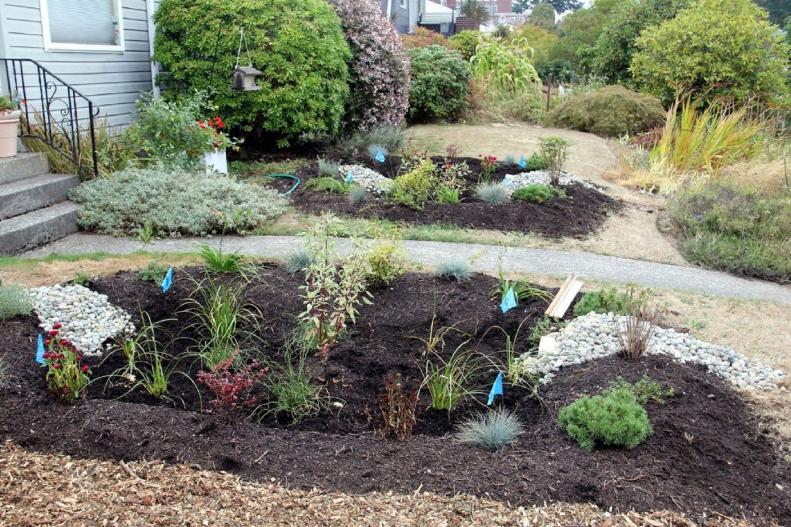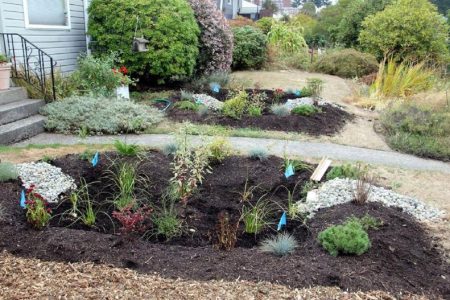
April 21, 2025 | Features, Sustainable Home Tips

Standing water in your lawn can be a nuisance and a potential hazard. It can damage your grass, create breeding grounds for mosquitoes, and even harm the foundation of your home. However, there are eco-friendly solutions to address this issue that won’t harm the environment. From french drains to rain gardens, there are a host of DIY-friendly (or not) solutions to try that can even add to your yard’s aesthetic.

Photo: RainDogDesigns.com/wordpress
Before diving into solutions, it’s essential to understand why your lawn has standing water. Common causes include:
Identifying the cause will help you choose the most effective solution.
Aeration: Aerating your lawn helps to break up compacted soil, allowing water to penetrate deeper. This can be done using a manual or mechanical aerator. Aeration also promotes healthy root growth and reduces runoff.
Organic Matter: Adding compost or organic matter to your soil can improve its structure and drainage capabilities. Organic matter helps to create air pockets in the soil, which facilitates water movement and absorption.
A rain garden is a beautiful and functional way to manage excess water. It’s a shallow, planted depression that collects and absorbs runoff from roofs, driveways, and lawns.
Plants: Choose native plants that are adapted to local conditions and can tolerate both wet and dry periods. Examples include Black-Eyed Susan, Blue Flag Iris, and Swamp Milkweed.
Design: Ensure your rain garden is located at least 10 feet away from your home to prevent water from seeping into the foundation. Dig a shallow basin, fill it with a mixture of sand, compost, and native soil, and plant your selected species.
A French drain is a trench filled with gravel or rock containing a perforated pipe that redirects surface water and groundwater away from an area.
Installation: Dig a trench that slopes away from the waterlogged area. Line it with landscape fabric to prevent soil from clogging the drain. Place the perforated pipe in the trench, cover it with gravel, and then with soil and sod.
If standing water is an issue on driveways or walkways, consider using permeable paving materials. These materials allow water to seep through and reduce runoff.
Materials: Options include permeable concrete, porous asphalt, and interlocking pavers. These materials not only help manage water but also reduce heat island effects and improve groundwater recharge.
A wet meadow is a low-maintenance, eco-friendly solution for areas prone to standing water. It involves planting water-tolerant grasses and wildflowers that thrive in wet conditions.
Benefits: Wet meadows provide habitat for wildlife, reduce erosion, and filter pollutants from runoff. Suitable plants include sedges, rushes, and wet-tolerant wildflowers like Joe Pye Weed and Cardinal Flower.
Installing a rain barrel or a larger rainwater harvesting system can help you collect and reuse rainwater, reducing the amount of water that ends up in your lawn.
Uses: Collected rainwater can be used for irrigation, reducing your need for tap water and helping to manage excess water more effectively.
In addition to addressing existing standing water, there are several preventative measures you can take:
At Pigybak, we understand the importance of sustainable home maintenance. By bundling home services with your neighbors, you can share contractors, reducing the number of trips and emissions. Imagine hiring a landscaper through Pigybak who can install rain gardens or French drains for multiple homes in your neighborhood. This not only saves money but also minimizes the carbon footprint of your home improvement projects.
Ready to make your lawn eco-friendly and manage standing water sustainably? Sign up for Pigybak today and discover how you can collaborate with your neighbors to hire top-rated contractors for all your home improvement needs. Let’s work together to create a greener, more sustainable community!
By adopting these eco-friendly solutions, you can effectively manage standing water in your lawn while contributing to a healthier environment. Happy gardening!
Sources:

I, [Customer Name], hereby authorize Pigybak to include my name, phone number, and address in their database. I also opt-in to receive notifications about upcoming services in my area. I validate that the information provided is accurate and represents my personal information, not others.
By providing this authorization, I understand and agree to the following terms:
I authorize Pigybak to set up a profile on my behalf, which may include my name, phone number, and address.
I consent to receiving notifications from Pigybak about upcoming services in my area via text message.
I acknowledge that I have the option to opt out of receiving notifications at any time. I can do so by directly contacting the contractor or managing my preferences in the Pigybak app.
I authorize Pigybak to share my contact information with the contracted service providers for the purpose of facilitating service delivery.
Pigybak agrees not to share my information with third parties without obtaining separate authorization from me.
I understand that Pigybak may update the terms and conditions, and I agree to review them periodically for any changes.
I acknowledge that the standard terms and conditions of the Pigybak mobile application, which can be found at www.pigybak.com/privacy-policy, apply to this authorization.
I acknowledge that this authorization is voluntary, and I have read and understood the terms outlined above. By providing my information, I consent to the terms above.

